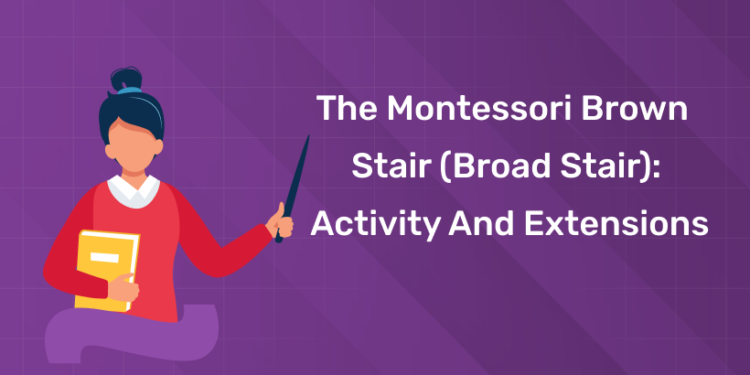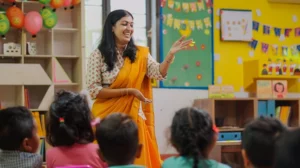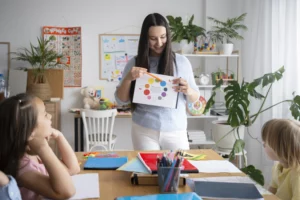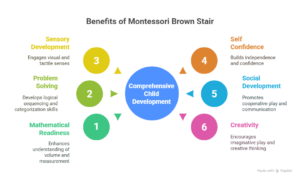Table of Contents
Imagine a child stacking wooden prisms with focus, unlocking math and creativity through play. The Montessori method, celebrated for its self-directed learning and sensory-rich approach, empowers children to explore independently. At its heart lies the Montessori Brown Stair (or Broad Stair), a powerful tool that introduces size, dimensions, and spatial awareness in a hands-on way. In 2025, as Kerala’s Montessori schools see 60% enrollment growth, this sensorial material is transforming early education. The Entri Montessori Teacher Training Course equips educators to maximize its impact. Whether you’re a parent, teacher, or Montessori enthusiast, this blog dives deep into the Brown Stair’s purpose, benefits, and role in shaping young minds for cognitive and sensory growth.
In this post we will go into the Montessori Brown Stair in depth—its purpose, benefits and how it helps shape a child’s learning journey. Whether you are a parent, educator or Montessori enthusiast, knowing how to use the Brown Stair effectively can help with cognitive and sensory development in young children.
Unlock your passion for education as a Montessori teacher!
Introduction
The Montessori Brown Stair is one of the classic Montessori materials, often seen with other foundational materials like the Pink Tower and the Red Rods. It is used to develop a child’s visual and tactile sense of dimensions, especially thickness and subtly introduce mathematical concepts of geometry and volume.
This is a great example of the Montessori philosophy in action—children learn by manipulating concrete objects and then abstract the concepts later in life. The Brown Stair is introduced in the Montessori Sensorial curriculum around 3 years old. Its structure and activity goes beyond just play and supports many areas of cognitive development.
Before we get into the details, it’s worth noting that educators can benefit greatly from formal Montessori training. This training helps them fully understand how to guide children in these activities. Platforms like Entri offer Montessori Teacher Training Courses. These courses prepare educators to use the Brown Stair effectively and get the most out of young children.
You can see a demonstration of how the Brown Stair is used in this YouTube video.
What is the Montessori Brown Stair?
1: What is the primary focus of the first plane of development in the Montessori method?
The Montessori Brown Stair or Broad Stair is a set of 10 wooden blocks, all the same length (20 cm) but varying in thickness from 1 cm to 10 cm. Each block is 1 cm thicker than the previous one as the child progresses from the thinnest to the thickest. The uniform length of the blocks allows the child to focus only on the variation in thickness.
Children can arrange the blocks from thickest to thinnest or vice versa. This activity develops fine motor skills and helps children to see and distinguish between sizes, a skill essential in geometry and math.
Get Certified & Start Your Montessori Career
Montessori Teacher Training Course by Entri App: Gain expert skills, earn certification, and kickstart your teaching career.
Join Now!What is the purpose of Montessori Brown Stair?
The main purpose of the Montessori Brown Stair is to refine a child’s visual discrimination of size, thickness. But it’s more than that:
- Size and Dimension Awareness: By working with blocks of different thicknesses, children get to understand 3D space.
- Mathematical Foundations: Children start to intuitively understand mathematical concepts like sequencing, comparison (greater than/less than) and the base 10 system used in measurement and geometry.
- Hand-Eye Coordination and Motor Skills: Building with the stair blocks develops a child’s fine motor skills and hand-eye coordination.
- Preparation for Geometry: The different block sizes introduce children to basic geometric concepts like volume, proportions and measurements in a hands on way.
- Focus and Concentration: Assembling and disassembling the Brown Stair in the correct order helps children to focus and concentrate.
Through repeated use of the Brown Stair, children lay the foundation for more advanced math.
What are the benefits of Montessori Brown Stair?
Imagine a child carefully arranging wooden prisms, their focus unwavering as they discover patterns and sizes. The Montessori Brown Stair, a cornerstone sensorial material, does more than teach thickness—it sparks lifelong skills in young learners. Here are the key benefits of the Montessori Brown Stair, making it a game-changer for children and teachers alike.
-
Builds Mathematical Foundations: The Brown Stair introduces volume, measurement, and size gradation, laying a concrete foundation for abstract math. By handling 10 prisms of varying thickness, children develop numerical awareness, a skill linked to improved math performance, per 2025 cognitive studies. Teachers trained via Entri learn to guide this early math readiness, per course syllabus.
-
Sharpens Problem-Solving Skills: Arranging the prisms from thinnest to thickest challenges children to sequence logically. This hands-on task hones critical thinking as they categorize and compare, fostering problem-solving abilities essential for 21st-century learning. Entri’s training emphasizes logical sequencing, preparing educators for dynamic classrooms.
-
Enhances Sensory Exploration: The Brown Stair engages visual and tactile senses, helping children discern subtle differences in weight and dimension. This sensory refinement strengthens decision-making, encouraging mindful interaction with their environment, per Montessori principles..
-
Boosts Confidence and Autonomy: Designed for independent use, the Brown Stair empowers children to complete tasks solo, building self-confidence. Successfully aligning the prisms instills a sense of achievement, a core Montessori value.
-
Fosters Social Collaboration: In Montessori settings, children often share the Brown Stair, promoting cooperative play and communication. This teamwork nurtures social skills, vital for Kerala’s inclusive classrooms, where 25% more teaching jobs demand collaborative educators. Entri equips teachers to guide group dynamics.
-
Ignites Creativity and Imagination: Beyond ordering, children use the Brown Stair in imaginative play, building towers or patterns. This open-ended exploration sparks creativity, a top skill for future innovators.
Brown Stair Extensions
In Montessori, extensions help to deepen a child’s interest in the material and further learning. Here are a few extensions for the Brown Stair:
- With the Pink Tower: The Pink Tower and the Brown Stair are often used together to challenge the child’s visual discrimination of height, width and depth. Children can be asked to stack the Pink Tower cubes on the Brown Stair blocks or make different structures.
- Grading with Other Objects: Children can be asked to match the Brown Stair blocks with objects of the same thickness from their environment. For example, children can find objects around the classroom that match each block’s width, to further their understanding of dimensions.
- Introduce Vocabulary: Teachers can introduce vocabulary like thick, thin, thicker, and thinner. This helps children verbalize their observations and gain language skills for size and dimension.
- Building and Imaginative Play: The blocks can be used for building imaginative structures, for creativity and artistic expression.
These extensions also help to reinforce the concepts of the Brown Stair and give children opportunities for problem solving and co-operative play.
Enroll in Montessori Teachers Training Course! Get free Demo Here!
Get Certified & Start Your Montessori Career
Montessori Teacher Training Course by Entri App: Gain expert skills, earn certification, and kickstart your teaching career.
Join Now!Conclusion
The Montessori Brown Stair is a simple but powerful tool in the Montessori Sensorial curriculum. Introduces young children to size, dimension and thickness and concentration, problem solving and fine motor coordination. Through hands on and experimentation children begin to understand early maths concepts. And that will serve them for the rest of their education.
The Montessori Brown Stair provides opportunities for independent learning, creativity, and intellectual development. By using it with your child, you are helping them benefit from these opportunities. And by taking a Montessori Teachers Training Course on Entri you can help educators and parents to get the most out of Montessori materials like the Brown Stair and know how to guide children.
In summary the Montessori Brown Stair lays the foundation for mathematical learning and independence, self confidence and creativity in young children. Knowing and using this material correctly can make all the difference in a child’s life.
Sign up for the Montessori Teachers Training Course on Entri to learn more about Montessori philosophy. It goes into detail on Montessori methods including the Brown Stair and how to guide children.
Get Certified & Start Your Montessori Career
Montessori Teacher Training Course by Entri App: Gain expert skills, earn certification, and kickstart your teaching career.
Join Now!Frequently Asked Questions
What is the Montessori Brown Stair?
The Montessori Brown Stair is a sensorial tool made of ten wooden blocks varying in thickness, designed to help children develop visual and tactile discrimination of size and dimensions.
What is the purpose of the Montessori Brown Stair?
The Brown Stair helps children grasp mathematical concepts, particularly related to size, dimension, and thickness. It also refines their sensory perception.
At what age is the Montessori Brown Stair introduced?
The Brown Stair is typically introduced to children around the age of 3 during the Montessori Sensorial phase.
How does the Brown Stair benefit children’s learning?
It improves visual discrimination, fine motor skills, problem-solving abilities, and prepares children for more complex mathematical learning.
What are the extensions of the Montessori Brown Stair?
Common extensions include pairing the Brown Stair with the Pink Tower, using it in creative play, and matching the blocks with objects of similar thickness.
Can the Montessori Brown Stair be used for creative play?
Yes, children often use the Brown Stair for imaginative building and creative activities, enhancing their creativity.
How does the Brown Stair prepare children for geometry?
By manipulating blocks of varying thickness, children develop an intuitive understanding of geometric concepts like volume, size, and proportions.
How does Entri’s Montessori Course help educators?
Entri’s Montessori Teachers Training Course provides comprehensive training on using Montessori materials like the Brown Stair, helping educators understand and implement the Montessori method effectively.
Where can I learn more about the Montessori method?
You can enroll in Entri’s Montessori Teachers Training Course to deepen your understanding of Montessori principles and become a certified Montessori educator.

















